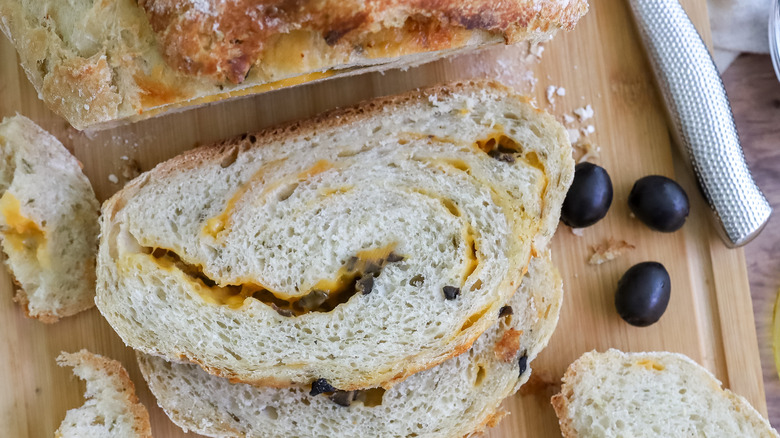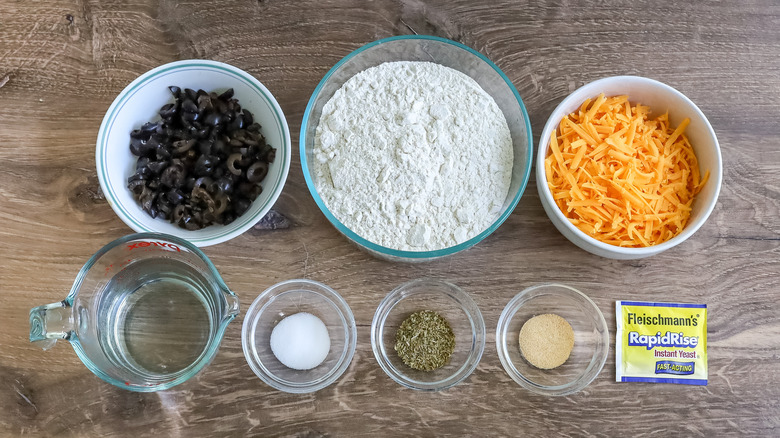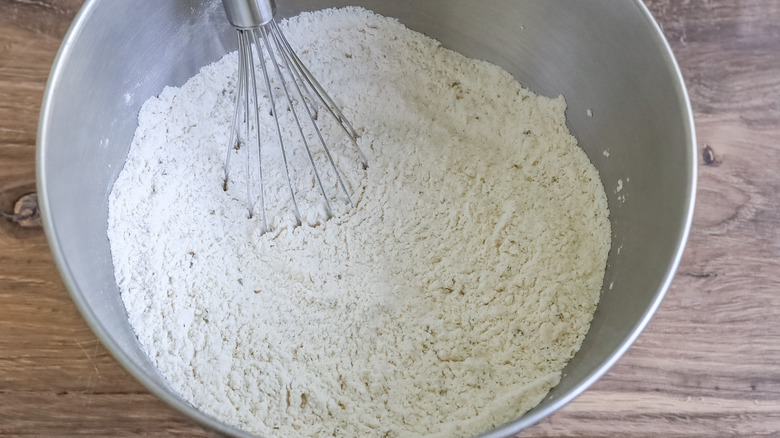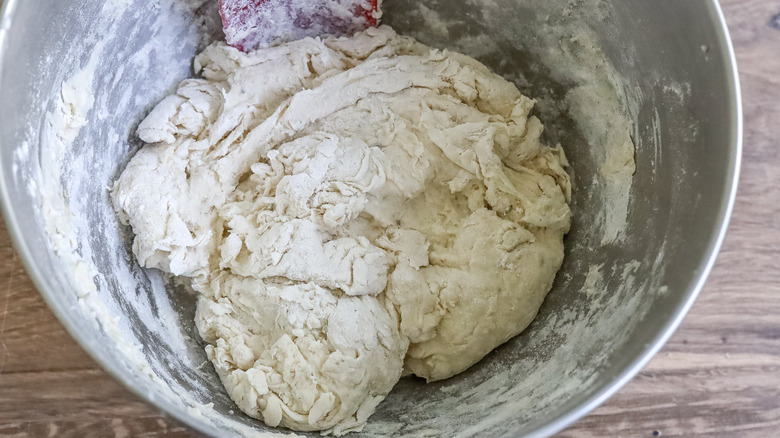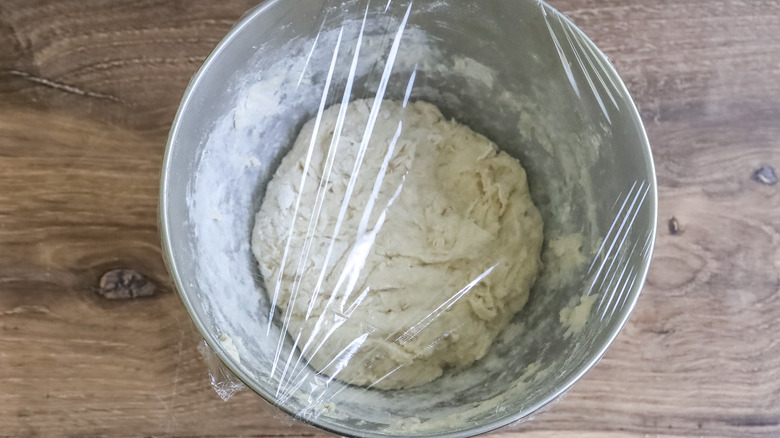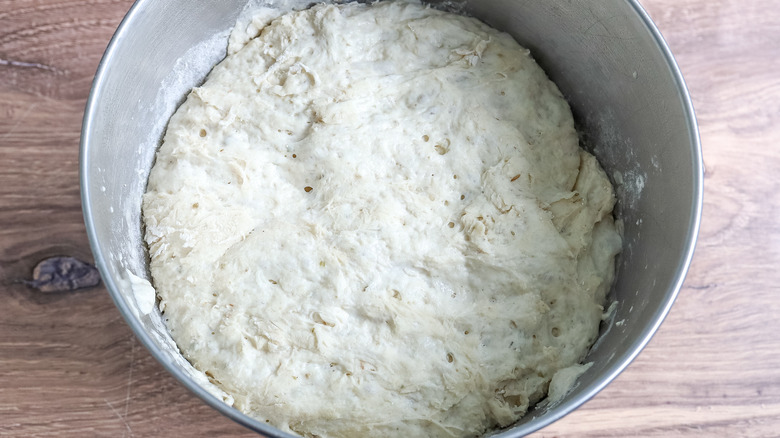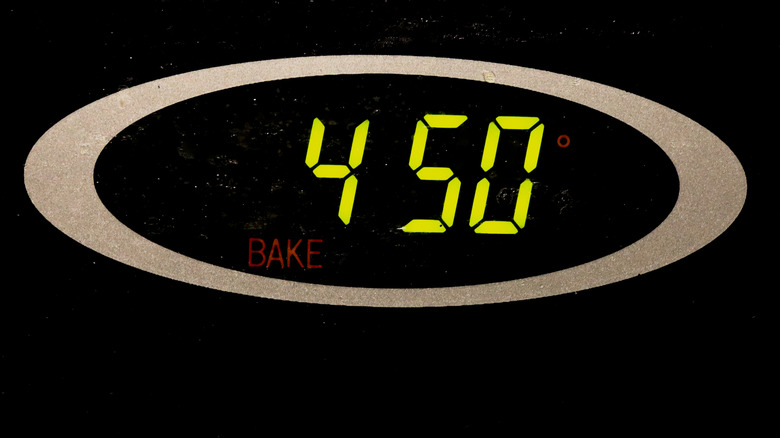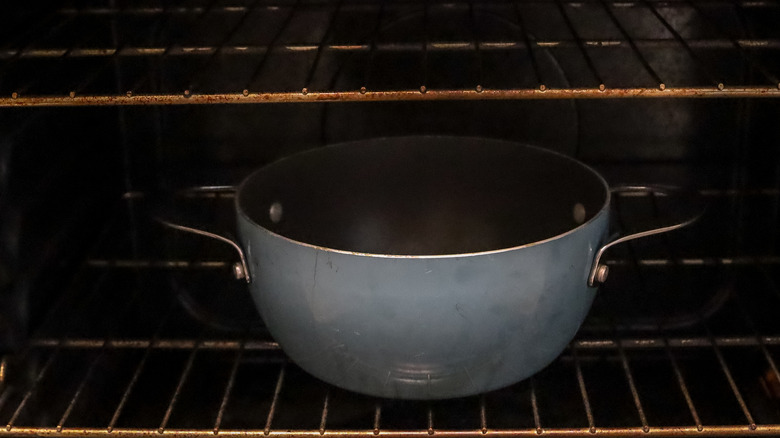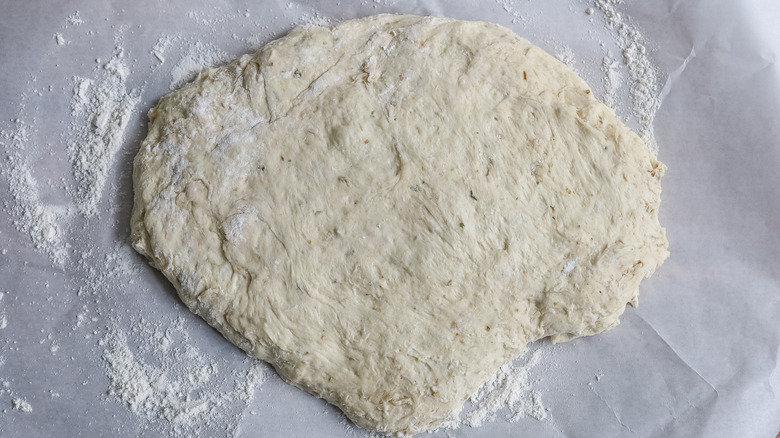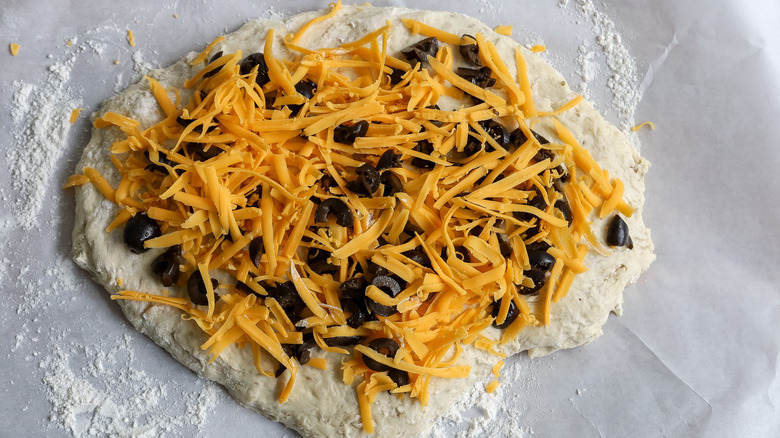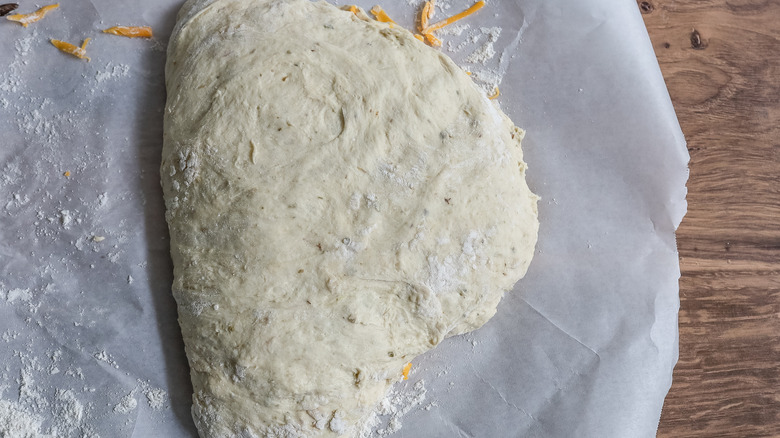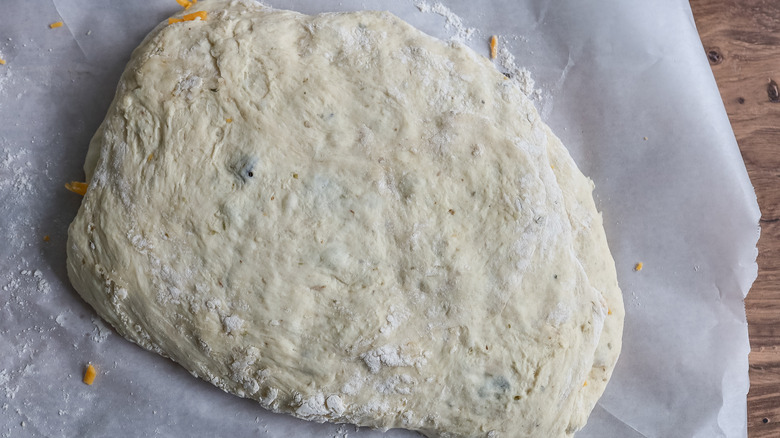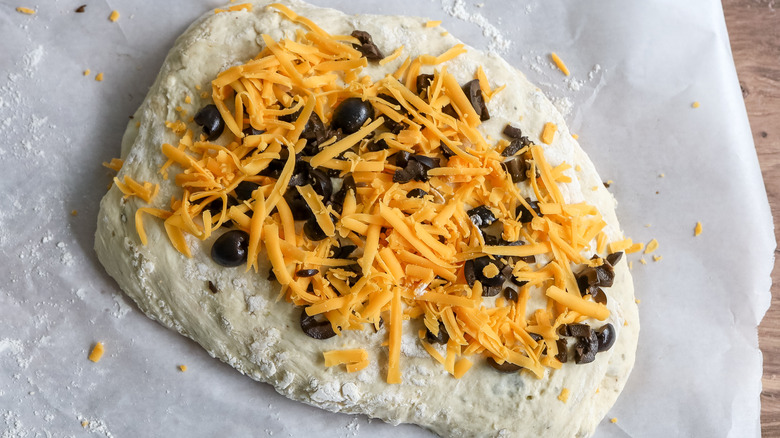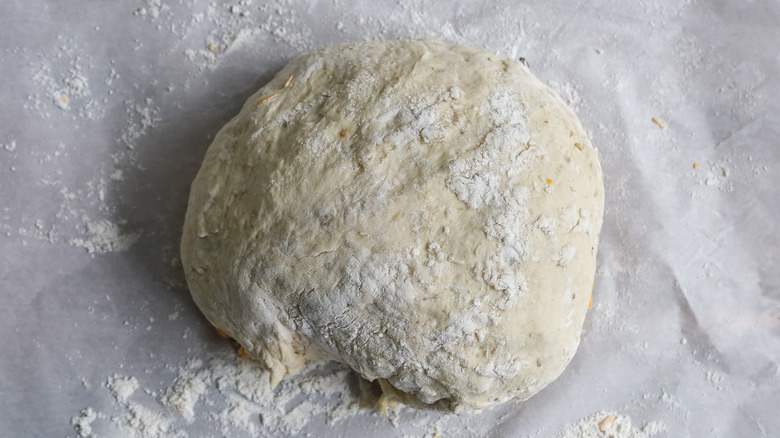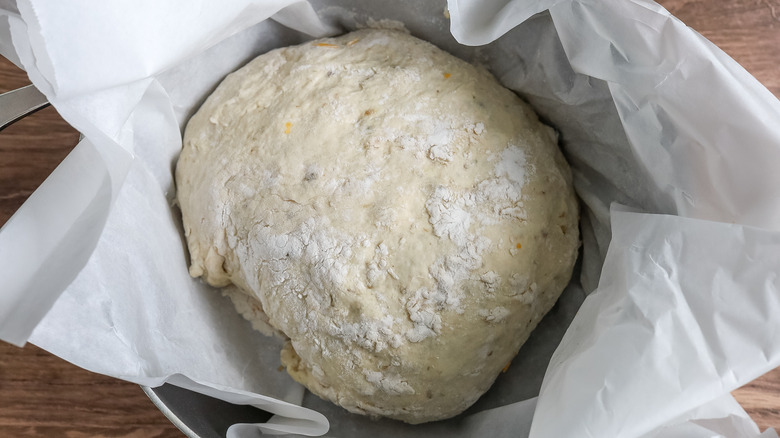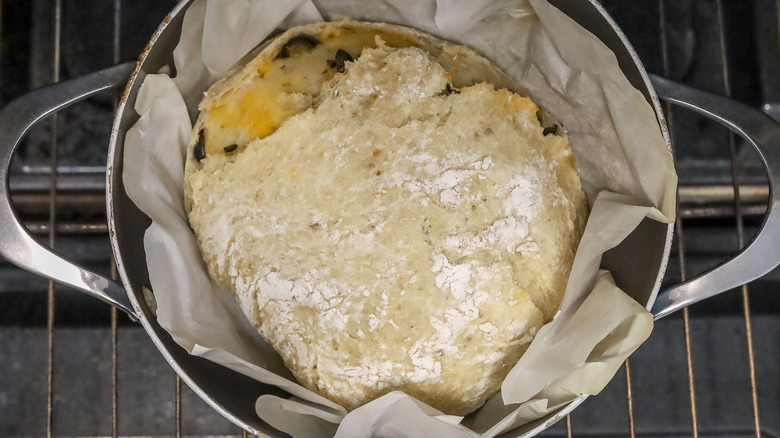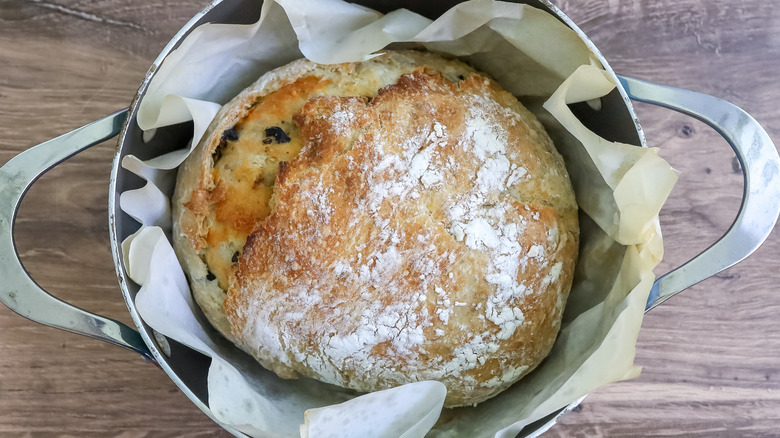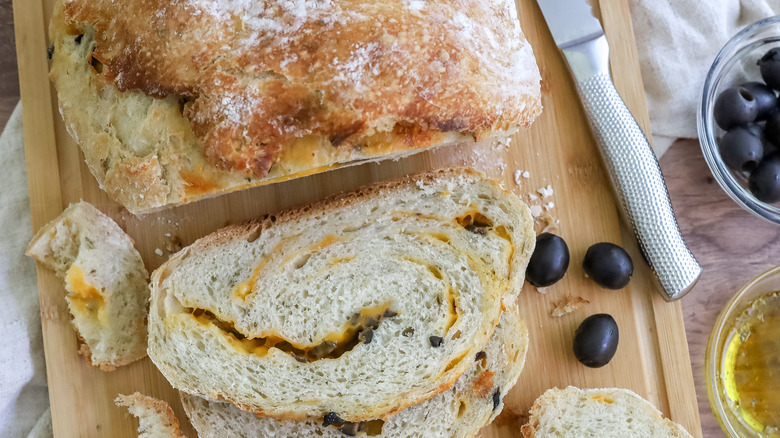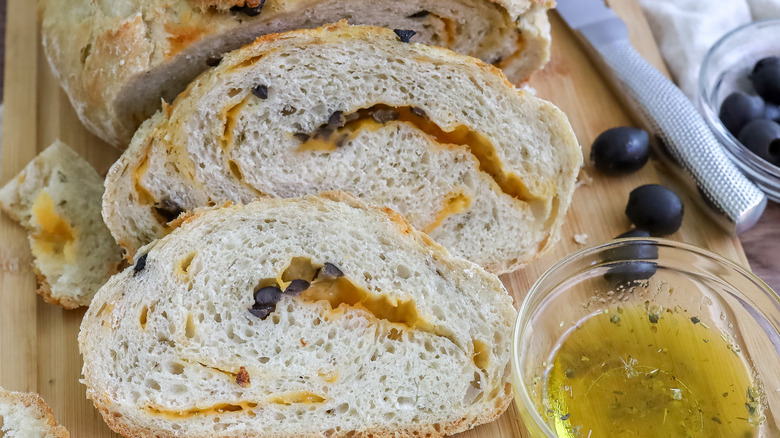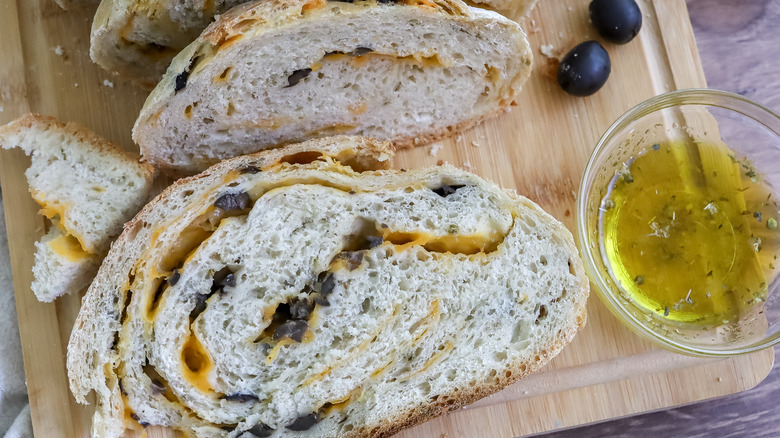No-Knead Olive Cheese Bread Recipe
The thought of making homemade bread can be daunting. There's usually a lot of kneading and resting and rise time involved, and it seems like everything can go wrong in so many ways. But this no-knead olive cheese bread recipe from developer Jessica Morone makes the process a whole lot easier. The bread dough itself is simply mixed up and then left to rise for a few hours before being stuffed with swirls of savory filling and then baked. There is only one rise involved with this bread, and because we use instant yeast, the bread will rise much more quickly than bread made with regular yeast or a sourdough starter. Within a few hours of starting this recipe, with very little effort, your kitchen will be filled with the aroma of homemade bread.
The use of a pre-heated Dutch oven in this recipe will give you a professional-looking, crusty loaf of bread with a light airy texture inside. You can eat this bread by itself, spread butter on top of it, or break up pieces and dip it in olive oil. You can even slice it and use it as a sandwich bread. However you serve it, you might find yourself wanting to make this versatile bread over and over again.
Gather the ingredients for this no-knead olive cheese bread
Before you start to make this recipe you will need to gather the ingredients. For the bread, you will need bread flour, instant yeast, salt, oregano, garlic powder, and water. And for the fillings, all you need are black olives and cheddar cheese.
If you would prefer to use all-purpose flour instead of bread flour you can substitute it at a 1:1 ratio. The bread might take longer to rise, not rise quite as high, and not be as chewy as if you use bread flour, but it will still be delicious. If you only have active dry yeast instead of instant yeast, make sure you activate it in warm water first. It may also take up to 50 % longer to rise than if you use instant yeast.
Step 1: Whisk the dry ingredients
In a large mixing bowl whisk together the flour, yeast, salt, oregano, and garlic powder.
Step 2: Add water and mix the dough
Pour the water into the bowl and mix together with a wooden spoon or rubber spatula until all the flour is moistened. The dough will be sticky and shaggy.
Step 3: Cover the bowl
Cover the bowl tightly with plastic wrap.
Step 4: Let the dough rise
Let it rise on your counter at room temperature for 2-3 hours until the dough doubles in size and has air bubbles on top.
Step 5: Preheat the oven
About 30 minutes before the bread is done rising, preheat the oven to 450 F.
Step 6: Heat a Dutch oven
Add an empty Dutch oven to the preheated oven and let it heat up for 30 minutes.
Step 7: Flatten the dough
Meanwhile, add the dough to a lightly floured piece of parchment paper and press it flat.
Step 8: Add olives and cheese
Sprinkle the dough with about one-third each of the chopped olives and shredded cheddar.
Step 9: Fold the dough
Fold the dough over in half so that the edges meet, and flatten the dough slightly.
Step 10: Add more olives and cheese
Add another one-third of the olives and cheese to the clean top of the dough.
Step 11: Fold the dough again
Fold the dough over again in half and flatten it.
Step 12: Add the remaining olives and cheese
Add the remaining one-third of the olives and cheese to the top of the dough.
Step 13: Fold the dough and form a ball
Fold the dough over one more time, and then shape it into a ball with the seam of the layers facing down on the parchment paper.
Step 14: Place the dough in the Dutch oven
Carefully remove the Dutch oven from the hot oven. Place the parchment paper with the dough on it into the Dutch oven.
Step 15: Cover and bake
Cover the Dutch oven with its lid (or with foil) and bake in the preheated oven for 30 minutes.
Step 16: Remove the cover and continue baking
Remove the cover from the Dutch oven and continue baking the bread uncovered for another 15-20 minutes until the bread is browned with a hard crust (you can also check that the internal temperature on a thermometer is at least 195 F)
Step 17: Slice and serve the bread
Remove the parchment paper with the bread on it from the Dutch oven, let the bread cool for at least 10 minutes and then slice and serve.
No-Knead Olive Cheese Bread Recipe
In only a few hours and with very little effort, your kitchen will be filled with the aroma of freshly-baked no-knead bread swirled with olives and cheddar.
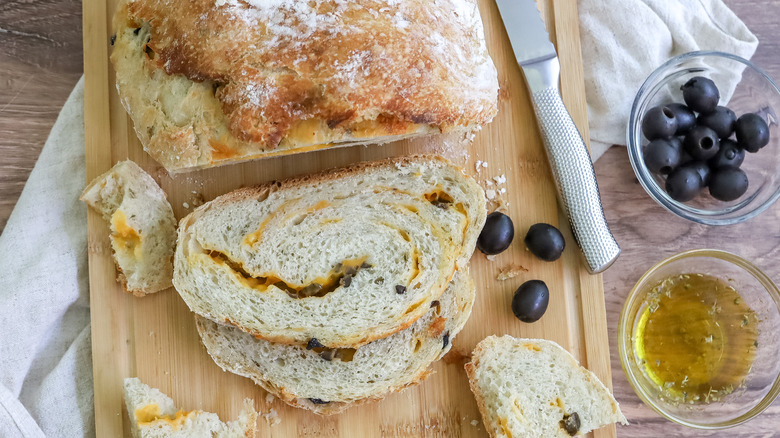
Ingredients
- 3 cups bread flour, plus more as needed for shaping and pan
- 2 ¼ teaspoons (1 packet) instant yeast
- 1 ½ teaspoon salt
- 2 teaspoons dried oregano
- 1 teaspoon garlic powder
- 1 ½ cups lukewarm water
- 1 cup roughly chopped pitted black olives
- 1 ½ cups shredded cheddar cheese
Directions
- In a large mixing bowl whisk together the flour, yeast, salt, oregano, and garlic powder.
- Pour the water into the bowl and mix together with a wooden spoon or rubber spatula until all the flour is moistened. The dough will be sticky and shaggy.
- Cover the bowl tightly with plastic wrap.
- Let it rise on your counter at room temperature for 2-3 hours until the dough doubles in size and has air bubbles on top.
- About 30 minutes before the bread is done rising, preheat the oven to 450 F.
- Add an empty Dutch oven to the preheated oven and let it heat up for 30 minutes.
- Meanwhile, add the dough to a lightly floured piece of parchment paper and press it flat.
- Sprinkle the dough with about one-third each of the chopped olives and shredded cheddar.
- Fold the dough over in half so that the edges meet, and flatten the dough slightly.
- Add another one-third of the olives and cheese to the clean top of the dough.
- Fold the dough over again in half and flatten it.
- Add the remaining one-third of the olives and cheese to the top of the dough.
- Fold the dough over one more time, and then shape it into a ball with the seam of the layers facing down on the parchment paper.
- Carefully remove the Dutch oven from the hot oven. Place the parchment paper with the dough on it into the Dutch oven.
- Cover the Dutch oven with its lid (or with foil) and bake in the preheated oven for 30 minutes.
- Remove the cover from the Dutch oven and continue baking the bread uncovered for another 15-20 minutes until the bread is browned with a hard crust (you can also check that the internal temperature on a thermometer is at least 195 F)
- Remove the parchment paper with the bread on it from the Dutch oven, let the bread cool for at least 10 minutes and then slice and serve.
Nutrition
| Calories per Serving | 237 |
| Total Fat | 7.9 g |
| Saturated Fat | 3.6 g |
| Trans Fat | 0.0 g |
| Cholesterol | 16.8 mg |
| Total Carbohydrates | 31.9 g |
| Dietary Fiber | 1.6 g |
| Total Sugars | 0.2 g |
| Sodium | 252.1 mg |
| Protein | 9.4 g |
How can I switch up the flavors in this olive and cheese bread?
Once you have the base dough recipe mastered you can switch up the fillings quite a bit. To keep it as an olive and cheese-based bread, you could try different types of olives, or a different type of cheese. If you use Kalamata olives and feta cheese, for example, you will have a loaf with lovely Greek flavors. The olives could also be replaced with something like roasted red peppers or artichoke hearts. Roasted peppers would pair well with goat cheese, and artichoke hearts would be delicious with mozzarella or Parmesan. For a bit of a spicier loaf, try jalapeños and a Mexican blend of cheeses. Because you are creating layers of filling every time the bread is folded, you could play around with a few complementary fillings in each layer.
The herbs in the dough can also be changed up for a different flavor combination. Instead of oregano, you could add rosemary, thyme, or basil. The bread can go in a sweeter direction if you leave out the oregano and garlic, replace them with cinnamon or nutmeg, and stuff the bread with raisins or dried cranberries. Finally, for an even easier option, you could just use the basic bread recipe by itself and skip the fillings, whether or not you decide to add oregano and garlic to the dough. You'll still have a delicious crusty loaf of bread.
How is no-knead bread different than bread that is kneaded?
The most obvious difference between no-knead bread and the kneaded kind is that you aren't doing as much manual work. The kneading process usually helps the gluten to develop, which causes the bread to be more airy and chewy. So you might think that a lack of working with the dough would lead to a more dense bread, but with no-knead bread that isn't the case. Most recipes for no-knead bread have a wetter, stickier dough, and the increased moisture causes it to be lighter and airier.
The other factor for a lot of no-knead bread recipes is time. Most sourdough recipes call for a fold-and-turn technique over hours (or sometimes days) because time is as effective in working the gluten as kneading — it develops as the dough rests. Because you aren't kneading the dough the rise time can be considerably longer, especially if you're using a sourdough starter. But because this recipe uses instant yeast, which is also "quick rise" yeast, it starts working immediately and causes a much faster rise. Within 3 hours of covering the dough, it should have risen to twice its original size and have air bubbles on the top, which will let you know that the dough is ready to be stuffed and baked, and that the resulting loaf will be light and chewy.
